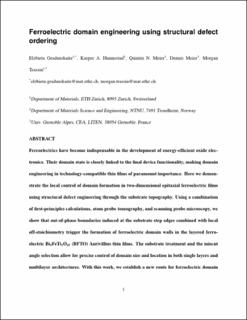| dc.contributor.author | Gradauskaite, Elzbieta | |
| dc.contributor.author | Hunnestad, Kasper Aas | |
| dc.contributor.author | Meier, Quintin | |
| dc.contributor.author | Meier, Dennis | |
| dc.contributor.author | Trassin, Morgan | |
| dc.date.accessioned | 2023-02-28T08:21:53Z | |
| dc.date.available | 2023-02-28T08:21:53Z | |
| dc.date.created | 2022-08-04T13:31:02Z | |
| dc.date.issued | 2022 | |
| dc.identifier.citation | Chemistry of Materials. 2022, 34 (14), 6468-6475. | en_US |
| dc.identifier.issn | 0897-4756 | |
| dc.identifier.uri | https://hdl.handle.net/11250/3054494 | |
| dc.description.abstract | Ferroelectrics have become indispensable in the development of energy-efficient oxide electronics. Their domain state is closely linked to the final device functionality, making domain engineering in technology-compatible thin films of paramount importance. Here we demonstrate the local control of domain formation in two-dimensional epitaxial ferroelectric films using structural defect engineering through the substrate topography. Using a combination of first-principles calculations, atom probe tomography, and scanning probe microscopy, we show that out-of-phase boundaries induced at the substrate step edges combined with local off-stoichiometry trigger the formation of ferroelectric domain walls in the layered ferroelectric Bi5FeTi3O15 Aurivillius thin films. The substrate treatment and the miscut angle selection allow for precise control of domain size and location in both single layers and multilayer architectures. With this work, we establish a new route for ferroelectric domain engineering and stabilization of functional domain walls in ultrathin ferroelectric layers. | en_US |
| dc.language.iso | eng | en_US |
| dc.publisher | American Chemical Society | en_US |
| dc.title | Ferroelectric Domain Engineering Using Structural Defect Ordering | en_US |
| dc.title.alternative | Ferroelectric Domain Engineering Using Structural Defect Ordering | en_US |
| dc.type | Peer reviewed | en_US |
| dc.type | Journal article | en_US |
| dc.description.version | acceptedVersion | en_US |
| dc.source.pagenumber | 6468-6475 | en_US |
| dc.source.volume | 34 | en_US |
| dc.source.journal | Chemistry of Materials | en_US |
| dc.source.issue | 14 | en_US |
| dc.identifier.doi | 10.1021/acs.chemmater.2c01178 | |
| dc.identifier.cristin | 2041172 | |
| dc.relation.project | Norges forskningsråd: 245963 | en_US |
| dc.relation.project | ERC-European Research Council: 863691 | en_US |
| dc.relation.project | Norges teknisk-naturvitenskapelige universitet: Department of Materials Science and Engineering | en_US |
| dc.relation.project | Norges teknisk-naturvitenskapelige universitet: Onsager Fellowship Program | en_US |
| dc.relation.project | Norges teknisk-naturvitenskapelige universitet: Outstanding Academic Fellows Program | en_US |
| cristin.ispublished | true | |
| cristin.fulltext | postprint | |
| cristin.qualitycode | 2 | |
